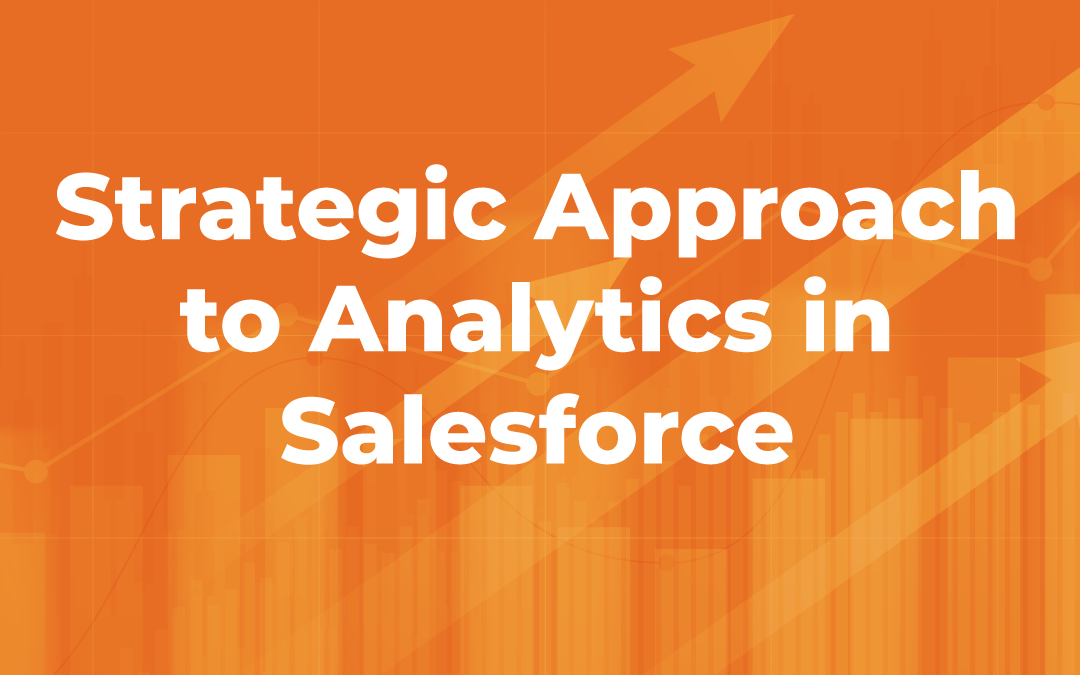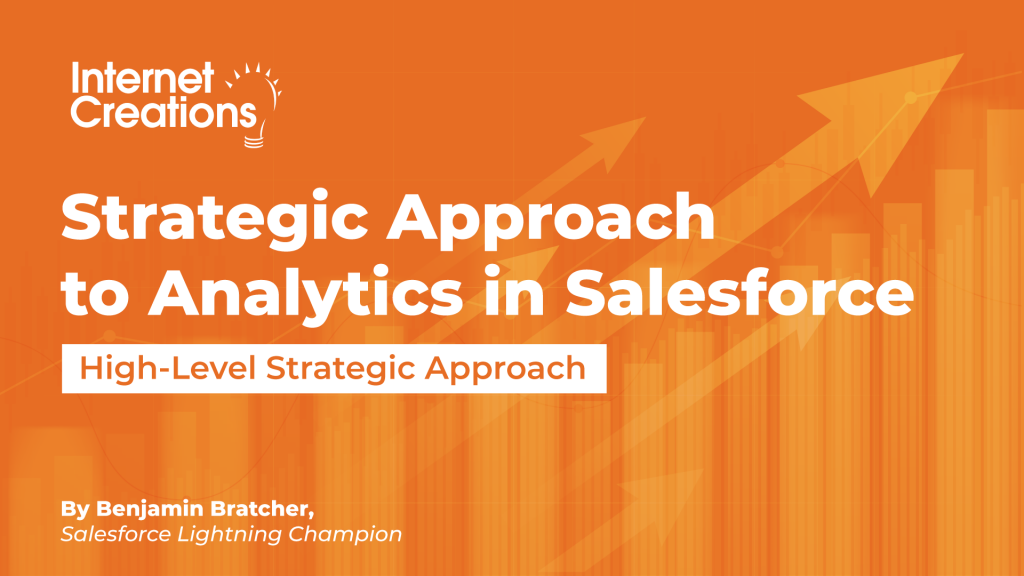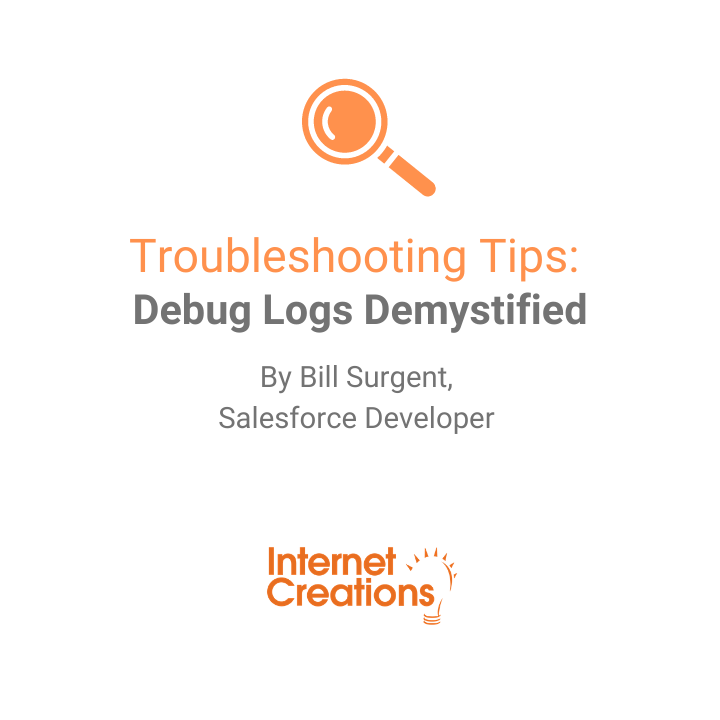Strategic Approach to Analytics in Salesforce

Author’s Note: This blog post is part of the Strategic Approach to Analytics in Salesforce series, which features the strategic approach to analytics of six leaders at Internet Creations. To view the entire series, click here.

Introduction
This blog post series, Strategic Approach to Analytics in Salesforce, takes a unique approach to analytics in Salesforce. My focus is geared towards the strategic approach organizations take with analytics at the executive level and within each department, rather than giving you a technical step-by-step overview of how to create reports and dashboards. Whom better to talk to about this than Internet Creations’ (IC) own leadership team?
Six of IC’s leaders took time out of their busy days to let me interview them about their strategic approach to analytics. This series synthesizes the strategies of the different departments at IC into cohesive blog posts. My hope is that this content will inspire other companies to analyze the role analytics plays at their organization.
You may ask yourself, “Why are analytics important?” Analytics are important to organizations because they bring objectivity to a subjective situation. Moreover, analytics enable you to make data-driven decisions, which allows you to inform the uncertain.
What you’ll learn from IC’s leaders in this series:
- High-Level Strategic Approach
- Key Metrics to Monitor
- Importance of Data Quality
- Confirmation Bias
- Tips and Traps with Analytics (including Salesforce Admin Analytics Best Practices)
- Cross-Departmental Collaboration and Alignment
- Key Takeaways
In the first blog post of the series, we will focus on the high-level strategic approach.
High-Level Strategic Approach
The main consideration as a leader of an organization is how you can leverage information in your decision making. Having the data is the first step, creating reports and dashboard is the second, but all of that is in vain if you aren’t able to derive business decisions from your findings. “Decision-making is a crucial part of my job as a marketing leader,” says Anthony Pica, IC’s Director of Marketing. Without data, it can be difficult to know how to navigate the future. Anthony uses data to challenge his assumptions. Whenever he needs to answer a business question, he often counts on his intuition based on prior experiences since that instinct can be quite powerful — especially when it comes to pattern recognition. However, he relies on data to act as the checks and balances on his intuition.
George Guhr, Director of Sales, points out that it’s crucial to use dashboards for decision making, but to make sure not to get analysis paralysis. Analysis paralysis is caused by overanalyzing or overthinking a situation that stifles the forward momentum of the company. Moreover, dashboards shouldn’t only be used to look at the numbers, but also need to have specific follow-up actions associated with them.
Steve Babula, Manager of Research & Development (R&D), usually has a strategic plan in mind and builds his dashboards to serve that purpose by tracking and monitoring performance. It is important to know what you want to track before diving into creating the analytics. “Start with the end in mind,” as Stephen Covey, Author of 7 Habits of Highly Effective People, put it best.
“If your car isn’t driving well, you look under the hood to diagnose what’s wrong, and then you attempt to fix it. Having a good dashboard is like looking under the hood of your organization.”
– Anthony Pica, Director of Marketing at Internet Creations
For an organization to operate effectively, it needs to be aligned across every department of the company in terms of the goals and metrics. The metrics within each department should roll up to the CEO’s goals. George Guhr makes a good point when he says, “Ideally, dashboards are constructed as a pyramid because generally organizational hierarchies are pyramids.”
“If I build the dashboard, then they’re using something their boss told them to use. If they build it, then they understand the importance of each of the metrics that is on the dashboard and why they’re looking at it. They’re much more likely to use it more often.”
Felisa Palagi, CEO at Internet Creations
IC’s CEO, Felisa Palagi, has a dashboard that captures the high-level company-wide metrics. From that dashboard, each department has their own dashboards that are specifically focused on the metrics that they are responsible for. Felisa strongly believes in empowering each director to create their own dashboards. “If I build the dashboard, then they’re using something their boss told them to use. If they build it, then they understand the importance of each of the metrics that is on the dashboard and why they’re looking at it. They’re much more likely to use it more often.”
At Internet Creations, the leadership team determines the company’s goals before the beginning of the year and works throughout the year towards meeting these goals. Anthony Pica recommends putting a dashboard of your goals somewhere with high visibility, such as your Salesforce homepage. You can visualize your performance and progress towards the goal in one spot and determine what adjustments need to be made to trend towards the goal.
Generally, George Guhr believes that dashboards are useless if we don’t look at them and act upon them. You should have actions that can be taken for every dashboard you create. Both George and Howard believe in the importance of sharing your dashboards with your team so everyone is working off of the same data. George does this by sharing links to the dashboards in most meetings he attends, including 1-on-1’s.
Stay tuned for more…
If you enjoyed learning about the high-level approach to analytics in Salesforce from IC’s leadership, make sure to subscribe to the Internet Creations blog by entering your information below. You will receive a monthly digest of blog posts including the next blog posts in the Strategic Approach to Analytics in Salesforce series.
Next up, we will be focused on Key Metrics to Monitor.
Enter your information to receive monthly updates featuring new posts from Internet Creations’ blog.
- Key Takeaways – Strategic Approach to Analytics - February 10, 2021
- Cross-Departmental Collaboration and Alignment - February 2, 2021
- 22 Tips and Traps with Analytics (with Admin Best Practices) - January 12, 2021


